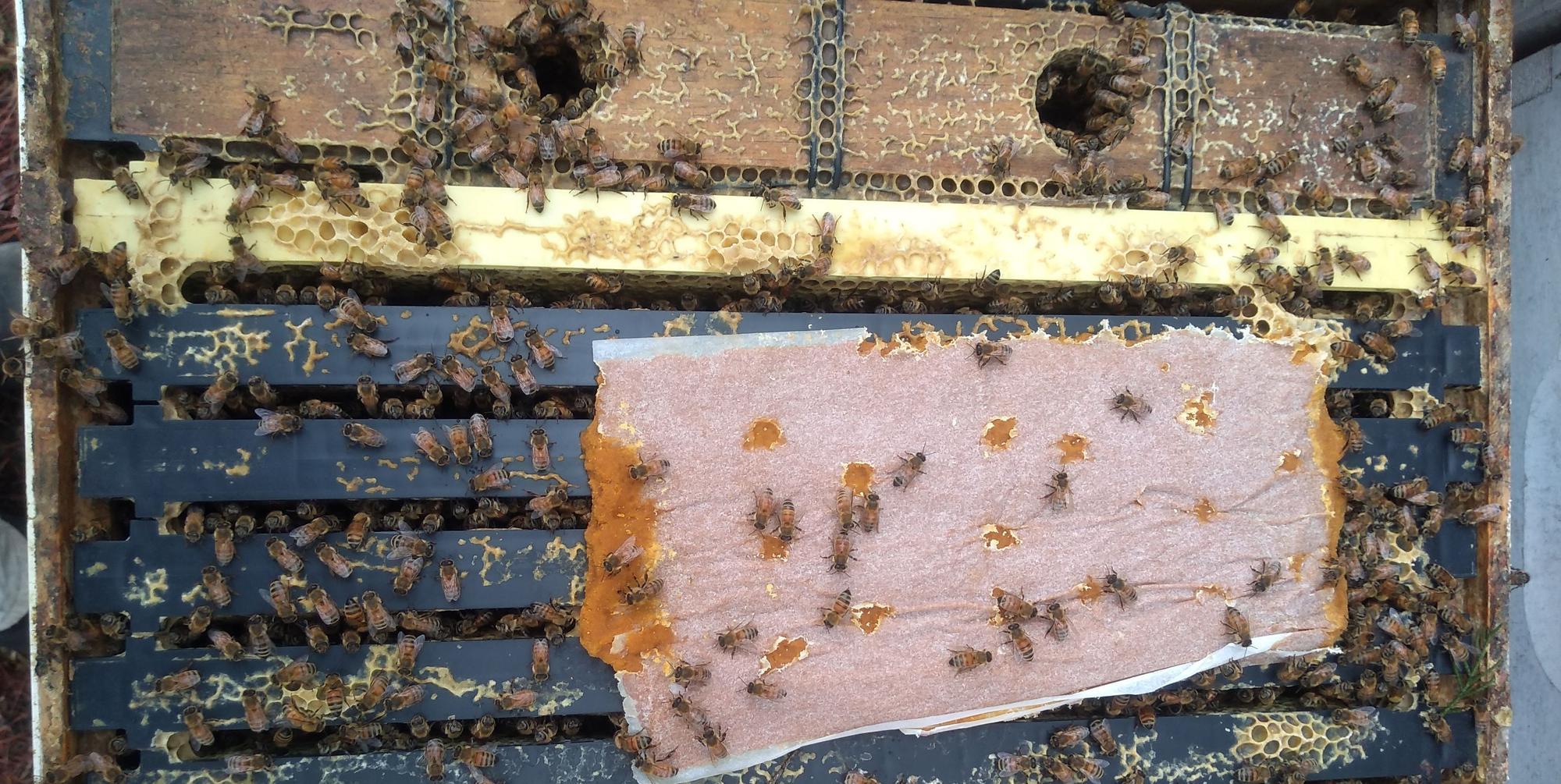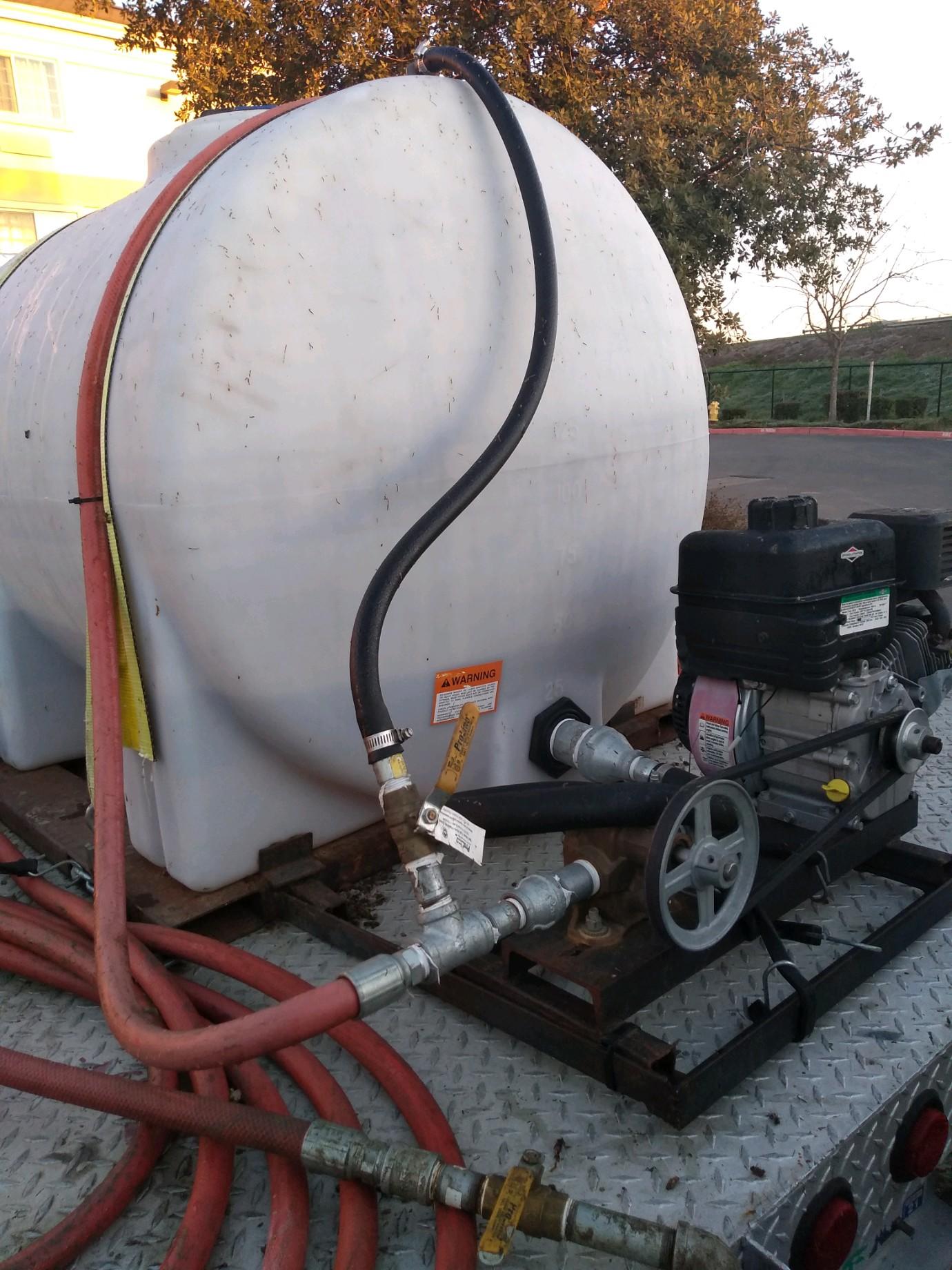Introduction
Success in pollination, honey production and other aspects of a beekeeping business depends on honey bee health. Strong, thriving colonies require many inputs from the beekeeper, including feed (carbohydrates and protein), medications and new queens when necessary.
Supplemental feed
Honey bees seek carbohydrate and protein sources by foraging for nectar and pollen during resource abundance. When floral resources are scarce, beekeepers may provide supplemental feed to colonies. The amount of feed provided to a colony will vary based on stored resources in the colony and environmental conditions. Beekeepers feed syrup and protein in spring to stimulate colony growth. They will also provide resources during inclement weather, late summer, and autumn to prepare colonies for winter. PNW commercial beekeepers report feeding colonies between 1.5 to 8 gallons of sugar syrup and 3 to 6.5 gallons of syrup in the autumn (Table 1, page 2).
A variety of feed products are available on the market. Syrup feed is either sucrose, high fructose corn syrup, or a blend of each. AGM and Cargill manufacture bulk syrup, but a beekeeper must go through a broker to purchase from these manufacturers. Prices fluctuate constantly and in early 2020 ranged between $0.29-$0.38 per pound ($3.30-$4.39 per gallon) (Table 3, page 3).
Table 1. Quantity of sugar syrup feed in Idaho and Oregon during spring and autumn
|
|
Season* |
Range (gal/colony) |
|
Idaho |
Spring |
2.5–8 |
|
Autumn |
3–4 |
|
|
Oregon |
Spring |
1.5–4 |
|
Autumn |
3–6.5 |
Source: Information gathered from PNW beekeepers
*Spring is defined as Jan. 1 to honey harvest and autumn is defined as honey harvest to Dec. 31.
Beekeepers also place 1-pound premade protein supplement patties inside colonies seasonally (Figure 1). PNW commercial beekeepers report feeding up to 6 pounds of protein in the spring and 4–8 pounds in the autumn (Table 2). The cost of premade protein supplement patties ranges from $1.09-$1.57 per pound (Table 3, page 3).
Table 2. Quantity of protein supplement feed in Idaho and Oregon during spring and autumn
|
|
Season* |
Range (lb/colony) |
|
Idaho |
Spring |
2–6 |
|
Autumn |
5–6 |
|
|
Oregon |
Spring |
0–4 |
|
Autumn |
4–8 |
Sources: Information gathered from PNW beekeepers.
*Spring is defined as Jan. 1 to honey harvest and autumn is defined as honey harvest to Dec. 31.
Table 3. Average and range of purchase cost for sugar syrup and protein supplement
|
|
Unit |
Average |
Range |
|
Syrup* |
$/lb |
$0.32 |
$0.29–$0.38 |
|
$/gal |
$3.81 |
$3.30–$4.39 |
|
|
Protein supplement** |
$/lb |
$1.25 |
$1.09–$1.57 |
Sources: Information gathered from PNW beekeepers, Dadant & Sons, Inc. (Hamilton, Illinois), Dakota Gunness, Inc. (Abercrombie, North Dakota), and Mann Lake Ltd. (Hackensack, Minnesota).
*Prices are for a full tank load (sold by hundredweight) and include a range of syrup types: high fructose corn syrup, sucrose and blends.
**Based on bulk prices of premade patties.
Syrup feeding systems
Beekeepers store and dispense sugar syrup to colonies with feeding systems that require a feed tank, pump and hose system (Table 4). A high-output pump and motor may be mounted and secured to the truck deck with a feed tank (Figure 2). A feed tank is often a reusable bulk container, such as an IBC tote, capable of holding 275 gallons of syrup (Figure 2). A variety of hoses and valves are needed to administer syrup from the feed tank to internal feeders in colonies.
Table 4. Range of purchase cost for feedingsystem equipment
|
Range ($/unit) |
|
|
Portable IBC syrup tank |
$75–$300 |
|
Truck pump |
$500–$1,200 |
Source: Information gathered from beekeepers.
Requeening
Young queens are productive and keep a colony at its top performance. Many beekeepers replace the queen (a process called requeening) annually and others do it on an as-needed basis. Beekeepers may need to requeen in a colony if the established queen is old, injured, performing poorly or lost. Losing a queen could be due to beekeeper error, a transportation mishap, pesticide damage or other causes. Beekeepers also requeen to break the brood cycle, a management technique to reduce Varroa mite reproduction or brood disease proliferation. The price of mated queens range from $24–$75 per queen, and queen cell prices range from $5–$8 per cell (Table 5). It may be more cost-effective for a beekeeper to incorporate queen production within their operation (refer to the “Further reading” section for an economic analysis).
Table 5. Average and range of purchase cost for mated queens and queen cells
|
Unit |
Average ($/unit) |
Range ($/unit) |
|
|
Mated queen |
Queen |
$28 |
$24–$38 |
|
Mated queen (specialty stock) |
Queen |
$55 |
$41–$75 |
|
Queen cell |
Cell |
$6 |
$5–$8 |
Sources: Information gathered from PNW beekeepers and American Bee Journal Marketplace advertisements.
Medication
Honey bees need routine management and treatment for a myriad of diseases and pests. The Varroa mite (Varroa destructor) is fatal to nearly all hives if left untreated or undertreated. Monitoring Varroa mite levels and responding timely with effective treatments is paramount to successful beekeeping. Organic and synthetic miticide treatment options are available to beekeepers with varying costs (Table 6, page 5). Each product has its own limitations, such as temperature requirements, restrictions on use during honey production and potential risk to queens. PNW commercial beekeepers report using two to four different miticides every year with several treatment applications in spring and autumn.
Table 6. Average purchase cost of miticide treatments for Varroa mite management*
|
Active ingredient |
Treatment trade name |
Dose quantity per purchase package |
Average cost per application unit |
Average cost per colony** |
|
Amitraz |
Apivar |
50 pack |
$2.75/strip |
$10.98 (4 strips) $5.49 (2 strips) |
|
Formic acid |
Formic Pro |
30 dose |
$2.41/strip |
$4.82 (2 strips) $2.41 (1 strip) |
|
Mite Away Quick Strips |
30 dose |
$2.21/strip |
$4.42 (2 strips) $2.21 (1 strip) |
|
|
Hop beta acid |
Hopguard II |
24 pack |
$2.16/strip |
$8.66 (4 strips) $4.33 (2 strips) |
|
Hopguard III |
5 pack |
$3.30/strip |
$13.18 (4 strips) $6.59 (2 strips) |
|
|
Oxalic acid |
Oxalic acid, dribble |
35 g |
$0.40/application |
$0.40 (1 application) |
|
Oxalic acid, vapor*** |
35 g |
$0.23/application |
$0.23 (1 application) $0.68 (3 applications) |
|
|
Thymol |
Apiguard |
3 kg |
$1.67/50 g |
$3.33 (2 applications of 50g) |
|
ApiLife VAR |
100 pack |
$1.65/tablet |
$4.95 (3 tablets) |
Sources: Dadant & Sons, Inc. (Hamilton, Illinois), Mann Lake Ltd. (Hackensack, Minnesota), and Western Bee Supplies, Inc. (Polson, Montana).
*We do not include coumaphos and fluvalinate products due to evidence of Varroa mite resistance to these products.
**Different options are provided due to varying colony sizes (see product labels for dosage information).
***The prices for the vaporizer and safety equipment are not included.
Several honey bee brood diseases require treatment or culling to limit transmission. Two serious brood diseases are American Foulbrood (AFB) and European Foulbrood (EFB), both of which can lead to a serious decline in colony health or death. Treatment options include antibiotic treatment or destroying infected equipment. A prescription or a veterinary feed directive from a veterinarian is required to obtain antibiotics for honey bees. The antibiotic Terramycin is approved to treat both European Foulbrood and American Foulbrood with a veterinary feed directive. However, American Foulbrood resistance to antibiotics has been reported. Terramycin is mixed in grease (extender) patties or powdered sugar. These products can be found at bee supply stores and are similar in price, ranging from $0.06–$0.92 per colony (Table 7, page 6). Tylosin tartrate (Tylan) and lincomycin hydrochloride (Lincomix) are alternative antibiotics approved for treating American Foulbrood. They require a prescription for purchase, so you can only obtain these products through your veterinarian. AFB resistance to Tylan or Lincomix has not been reported. However, prolonged use of antibiotics can lead to resistance.
Table 7. Average purchase cost of antibiotic treatments for foulbrood disease
|
Active ingredient |
Treatment trade name |
Disease treated |
Dose quantity per purchase package |
Treatment applications per colony |
Average cost per colony |
|
Oxytetracycline |
Terra-Patties |
AFB, EFB |
45 lb |
1 |
$0.92 |
|
Terra-Pro |
AFB, EFB |
40 lb |
3 |
$0.39 |
|
|
Terramycin 100MR |
AFB, EFB |
50 lb |
3 |
$0.06 |
|
|
Tylosin tartrate* |
Tylan |
AFB |
100 g |
3 |
$0.36 |
|
Lincomycin* |
Lincomix |
AFB |
160 g |
3 |
$0.05 |
Sources: Dadant & Sons, Inc. (Hamilton, Illinois), Mann Lake Ltd. (Hackensack, Minnesota), Petco Animal Supplies, Inc., and Heartland Veterinary Supply and Pharmacy.
*Tylosin tartrate and lincomycin are approved only for treating AFB. Price per colony does not include powdered sugar, which is required for mixing and application.
Wax moth does not negatively impact colony health in the PNW, but it is a pest that destroys stored equipment. The larvae consume wax and create dense webs that may render combs unusable. Wax moth control during winter storage is important for beekeepers to maintain comb integrity. Paradichlorobenzene (Para-Moth) controls wax moth during comb storage. Para-Moth treatment costs $0.34 per deep and $0.19 per medium box of frames (Table 8).
Some beekeepers use the antimicrobial agent fumagillin (Fumidil-B) to treat Nosema, a common gut infection. However, there is conflicting evidence that fumagillin reduces Nosema levels in honey bees. Beekeepers feed this medicated syrup to their colonies in the spring and/or autumn (Table 8).
Table 8. Average purchase cost of other treatments
|
Active ingredient |
Treatment trade name |
Unit |
Treatment applications |
Average cost per colony |
|
Fumagillin |
Fumidil-B |
12 500g bottles |
1 |
$1.73 |
|
Paradichlorobenzene |
Para-Moth |
5 lb |
1 |
$0.34/deep box $0.19/per medium box |
Sources: Dadant & Sons, Inc. (Hamilton, Illinois), Mann Lake Ltd. (Hackensack, Minnesota), and Western Bee Supplies, Inc. (Polson, Montana).
Further reading
Queen production
Bixby, M., S.E. Hoover, R. McCallum, A. Ibrahim, L. Ovinge, S. Olmstead, S.F. Pernal, A. Zayed, L.J. Foster and M.M. Guarna. 2020. Honey bee queen production: Canadian costing case study and profitability analysis. bioRxiv 2020.01.14.906461. doi: https://doi.org/10.1101/2020.01.14.906461
Identifying and mitigating pests and diseases
Honey Bee Health Coalition. 2019. Best management practices for hive health: A guide for beekeepers. honeybeehealthcoalition.org/wp-content/uploads/2019/01/HBHC_Hive_BMPs_v1.0_reduced.pdf
Honey Bee Health Coalition. 2019. Identifying and mitigating foulbrood in honey bee colonies and reducing the use of antibiotocs: information for beekeepers and veterinarians. honeybeehealthcoalition.org/wp-content/uploads/2019/06/HBHC__AFB-EFB-Final-061119.pdf
Honey Bee Health Coalition. 2018. Tools for Varroa management. honeybeehealthcoalition.org/varroa/
Pernal, S.F. and H. Clay (Eds.) 2013. Honey bee diseases and pests (3rd ed.). Canadian Association of Professional Apiculturists. 68 pp.
Technical-Transfer Teams. 2020. Diagnosis and Treatment of Common Honey Bee Diseases (2nd ed.). Bee Informed Partnership, Inc. 66 pp.
Beekeeping business plan guides
Daily, S., S. Jacobson, S. Kohler and J. Buchhelt. 2003. Beekeeping Business Plan Workbook.
Mussen, E. University of California, Division of Agriculture and Natural Resources. 1994. Starting a Small Beekeeping Operation.
Payne, S. Bee Culture. 2016. Strategic Business Planning. https://www.beeculture.com/strategic-business-planning/
Providence of British Columbia, Minister of Agriculture, Fisheries and Food. Preparing a business plan: a guide for agricultural producers beekeeper example. www2.gov.bc.ca/gov/content/industry/agriculture-seafood/animals-and-crops/animal-production/bees
Sanford, M. University of Florida, Florida Cooperative Extension Service. December 1992. A Study in Profitability for a Mid-Sized Beekeeping Operation. Fact Sheet No. RF-AA089. http://ufdcimages.uflib.ufl.edu/UF/00/07/71/22/00001/AA08900.PDF.
About this series
Budgeting for a Commercial Beekeeping Operation in the Pacific Northwest describes potential revenue streams and expenditures with a commercial beekeeping operation.
Fact Sheet 1: Revenue Sources for a Commercial Beekeeping Operation in the Pacific Northwest
Fact Sheet 2: Operational Equipment Expenses for a Commercial Beekeeping Operation in the Pacific Northwest
Fact Sheet 3: Beekeeping Equipment Expenses: Woodenware and Other Components
Fact Sheet 4: Honey Bee Colony Maintenance Expenses
© 2020 Oregon State University.





